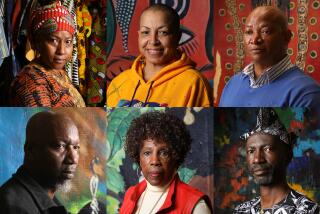STYLE: DESIGN : HATS OFF
The cat in the hat is just a children’s rhyme--unless, of course, it’s designed, crafted and worn in Africa, where headwear might resemble a ferocious jungle beast and be fashioned from its hide and bones. As in America, the African art of making hats combines style and skill. But unlike millinery as we know it, African artists turn plants (in the form of bark, cotton, seed pods), animals (hair, horns, feathers) and minerals (mud, stone, metal) into objects that do much more than protect the head.
The exhibit “Crowning Achievements,” opening next Sunday at UCLA’s Fowler Museum of Cultural History, offers a fascinating survey of African headdresses from the past two centuries. It shows how local materials are meticulously assembled--almost always by hand--in ways dictated by tradition. The results communicate not only trends in contemporary dress but also the person’s ethnic or regional identity, age, gender, occupation and status.
In Nigeria, for example, Bura women burn intricate patterns into dried gourds to make bonnets that reveal their baby’s ethnic heritage. Only Kalabari Ijo chiefs are allowed to wear ajibulu , flashy crescent-shaped hats of ram’s beard, plumage and circular symbols that convey power and wealth. And among the Ejagham people, a coiled hairstyle once worn by marriageable women now appears in a mask-like wood headdress reserved for the initiation rites and funerals of members of men’s societies. What’s worn on the head becomes practical accouterment, fashion statement and personal billboard.
In Africa, it could be said, a hat is worth a thousand words.


